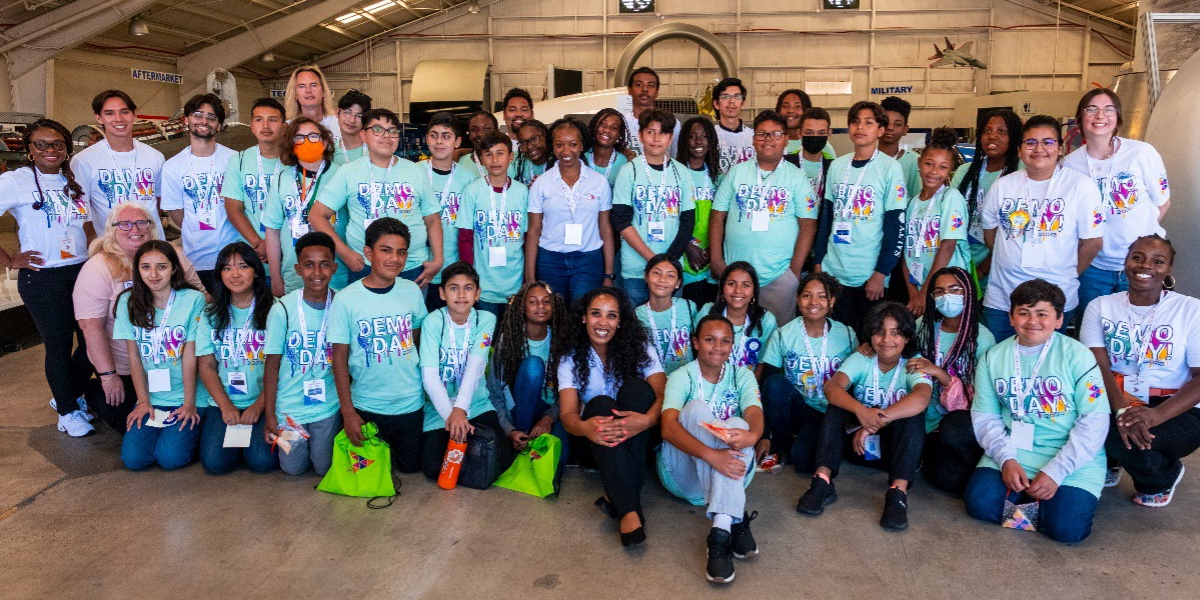When Jasmine LeFlore thinks about sharing some of her favorite success stories of middle and high school students transformed by Greater Than Tech, her face beams as she grins from ear to ear.
“I’ve seen kids transform from not really interested, want nothing to do with [STEM] to ‘Oh my gosh! I can’t believe I built a whole robot, pitched a business and now I have this Roblox card [game]!’”
A San Diego Foundation (SDF) Science & Technology Program nonprofit partner, Greater Than Tech (GTT) is dedicated to building the next generation of diverse and innovative technology business leaders while providing equal opportunities to underrepresented youth in the greater San Diego region.
The organization was started in 2020 by two women of color engineer-leaders, Jasmine LeFlore, co-founder and Executive Director, and Dr. Brittany Wheeler, co-founder and Director of Education, who understand the importance of self-efficacy, science, technology, engineering, and mathematics (STEM) entrepreneurship and social impact.
GTT provides students with hands-on experience in technology and robotics through its workshops, demonstration days, development programs and training. These programs help students gain skills in business development, teamwork and leadership to build confidence and guide them toward a career in STEM.
Underrepresentation in STEM
According to the Pew Research Center, Black and Latino/a workers remain underrepresented in the STEM workforce compared with their share of all workers. Women, too, are underrepresented in certain STEM occupations such as the physical sciences, computing and engineering.
Black and Latino/a adults are less likely to earn STEM degrees and make up a lower share of STEM graduates relative to their share of the adult population. While women earn most of all undergraduate and advanced degrees, they remain a small share of degree earners in fields like engineering and computer science, and are less represented in the workforce.
Why Greater Than Tech
As one of a few women of color in their departments and industry, Jasmine LeFlore (pictured left) and Dr. Brittany Wheeler (pictured right) started GTT based on their own isolation in the industry, noticing a disparity amongst robotics students.
Years ago, when Jasmine and Brittany were pursuing an MBA and doctorate degree in engineering, respectively, they worked part-time as robotics instructors for a middle school girls’ team. During this time, they saw that girls of color did not grasp the robotics material as quickly as others.
“We found that the girls of color probably didn’t have parents who knew about STEM and went to schools that didn’t have a lot of STEM opportunities… It was their first time and was a little daunting,” Jasmine says.
“We couldn’t catch the girls up who didn’t have the background, so it felt like we were seeing a disparity … in the classroom.”
The program for middle school girls consists of competitions among robotics teams. However, competitions are challenging due to the many rules. For example, the girls work hard, but their robot touches a line and gets disqualified.
Jasmine shares that affluent students often possess a robotics background and have access to more resources to help them excel, which can discourage some students.
To combat this, Jasmine and Brittany developed a program that focuses on demonstrations rather than competitions to create an environment where all students can learn robotics together. They also want to incorporate a pitching aspect where students can choose a social impact initiative they want to solve and present their robot business and demonstration to have a more positive impact on the students and their evaluation of their journey in STEM.
Importance of Diversity and Inclusion
Jasmine and Brittany understand the importance of diversity and inclusion.
“Diversity doesn’t necessarily have to be only ethnicity and gender, it can also be diversity of ideas, neurodivergent and diversity in a lot of different factors. It’s very important because that’s how you get better innovative outcomes,” Jasmine says.
In GTT’s robotics program, they provide students with state-of-the-art technology and give students a variety of topics related to poverty, world hunger and clean water, among other initiatives. Jasmine shares that when it comes time for students to present, they come up with phenomenal ideas that would help others.
GTT aims to help students residing in the San Diego Promise Zone. These areas of our region, such as the southeastern San Diego and Barrio Logan, are culturally diverse but have historically experienced under-investment by local government and industry. To provide equal opportunities for these students, GTT visits schools and STEM fairs in these neighborhoods to introduce and encourage students to join their STEM programs.
Empowering Students
GTT offers all its students a hands-on experience through its workshops, demonstration days, development programs and training. Jasmine and Brittany know that measuring the success of their STEM programs is incredibly important and a reason that they are consistent with capturing quantitative and qualitative data.
Through all the student success stories GTT has seen over the years, Jasmine recalls an inspiring story about the transformation she saw in a student named Jacquie.
Jacquie joined the GTT program with an interest in STEM and starting her own robotics company. Now, Jacquie is studying mechanical engineering at Colombia University, minoring in robotics and participating in an entrepreneurship camp. Jasmine shares that she can see that Jacquie is clearly on the path to becoming a future tech entrepreneur.
“It is so phenomenal…in a lot of ways, just to see someone who is on the path at 18 years old and really going down it… the sky’s the limit,” Jasmine says.
It’s through student stories like Jacquie’s that Jasmine sees how bringing STEM education and entrepreneurship together can open the eyes of their students to strive and decide what their careers will look like in STEM.
What’s Next for Greater Than Tech
Jasmine shares a few GTT goals such as a lab for more prototyping. GTT has a lot of exploratory programs that currently focus on robotics kits. Ideally, they want students to design their robots from the ground up.
Another area of focus is specialized emerging technologies, enabling students to do more with cutting-edge technology like solar. By expanding its programs, GTT can introduce students to a wider range of career pathways in STEM.
GTT seeks more opportunities to collaborate with local organizations, universities and incubators that possess advanced technology and are interested in extending outreach to middle and high school students.
The SDF Science & Technology Program promotes STEM education to underrepresented young adults. Since 1999, the program has granted more than $10.3 million to support scientists and engineers in San Diego. The program is funded in part by the Blasker-Rose-Miah Endowment Fund at SDF and The Reuben H. Fleet Foundation.










